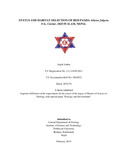Please use this identifier to cite or link to this item:
https://elibrary.tucl.edu.np/handle/123456789/1447| Title: | Status and Habitat Selection of Red Panda Ailurus fulgens F.G. Cuvier, 1825 in Ilam, Nepal |
| Authors: | Limbu, Anjali |
| Keywords: | Status;Habitat Selection |
| Issue Date: | 2019 |
| Publisher: | Central Departmental of Zoology |
| Abstract: | Adequate information on the distribution, habitat preference and threats of Red Panda(Ailurus fulgens fulgens) is lacking in Nepal, especially outside of protected areas. This studyaimed to assess distribution and relative abundance; habitat use and explore the conservationthreats of Red Panda in 5 blocks of 4 Community forests namely Singadevi, Chitre-Hile,Chhipchhipe and Kalikhop-dadheli of Eastern Ilam, Nepal in April-May 2018. The studyincluded the Reconnaissance survey for specific site selection and Red Panda sign survey toestimate distribution and abundance. Habitat was studied along horizontal survey line(altitudinal line intercept) at altitudinal interval of 100m, where tree species were sampled byten tree plotless method. Vegetation analysis of bamboo, shrub and herb was done by usingquadrate method within each panda sign plot and systematic plot. Threats for Red Pandawere studied by direct observation and questionnaire method. Altogether 23 transectssumming to 23 km were established along with 92 systematic and41 panda sign plots. Thestudy revealed presence of Red Panda in all four community forests with clumped pattern offecal group distribution and Red Pandas were evenly distributed in different habitat typeavailable. The evidences were scattered from 2,200 to 2,700 m asl and more abundant from2,400m-2,500m asl. A Red Panda was noticed directly during study (26.99918 N, 088.089 E) in Singadevi block. Habitat features were analyzed using generalized linear modelmethod. Among the 13 habitat variables used, bamboo density (E=0.022162, P<0.05,S.E=0.008604), bamboo cover (E=-0.049678, P<0.05, S.E=0.022408), water distance (E=-0.009805, P<0.05, S.E=0.002518), altitude (E=-0.007647, P<0.05, S.E=0.003269), canopycover (E=0.049195, P<0.05, S.E=0.021659) and slope (E= -0.102326, P<0.05,S.E=0.058709) showed significant impact in the likelihood of habitat selection by RedPanda. Red Panda preferred the area with dense bamboo density and canopy cover. Middlealtitudinal range of study area (moderately steep slope)which is close to water sourceshaving less bamboo cover was preferred by them. The most preferred site of defecation byRed Panda was tree (78.12%) followed by forest floor (15.62%) and rocks (6.25%). The mostimportant tree species in Red Panda habitat wereLithocarpus pachyphylla (IVI = 45.05),Symplocus theifolia (IVI= 37.19), Symplocus pyrifolia (IVI =20.99), Quercus lamellose(IVI= 19.25),Magnolis campbelli (IVI= 17.25) etc. Shrub species of Arundinaria maling,Daphne bhoua,Viburnum erubescens, Eupatorium adenophorumand the herbs likePterissp.,Elastostema sessile,Rubus sp.,Viota sp.etc were found to be the most preferred speciesby Red Panda. Livestock grazing, Human disturbances and Malingo cutting were the majorthreats associated with Red Panda in the study area. Out of total disturbance counts, thehighest 41% was livestock grazing. The threats can be minimized by launching ofconservation awareness program, strict implementation of rules and regulations andlivelihood development program ofvillagers. |
| URI: | http://elibrary.tucl.edu.np/handle/123456789/1447 |
| Appears in Collections: | Zoology |
Files in This Item:
| File | Description | Size | Format | |
|---|---|---|---|---|
| Cover.pdf | 65.94 kB | Adobe PDF |  View/Open | |
| Chapter.pdf | 3.22 MB | Adobe PDF |  View/Open |
Items in DSpace are protected by copyright, with all rights reserved, unless otherwise indicated.
